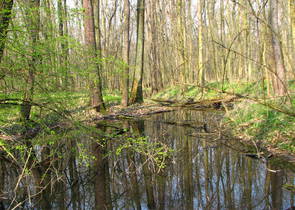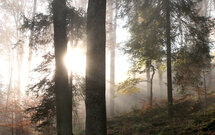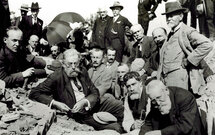The Journal is published by the Nature Conservation Agency of the Czech Republic in cooperation with the Cave Administration of the Czech Republic, the Krkonoše Mts. National Park Administration, the Bohemian Forest Mts. National Park Administration, the Podyjí National Park Administration and the The Bohemian Switzerland National Park Administration. It has been published since 1946.
cs / en
Nature Conservation 5/2008 — 21. 10. 2008 — On Nature in the Czech Republic
The Libický luh Floodplain National Nature Reserve

The Libický luh Floodplain is located at an altitude of approx. 190 m a. s. l., at the confluence of the Elbe and Vltava Rivers and it is the most extensive floodplain forest in Bohemia.
Elbe River meandering stream which formed a lot of pools and cut-off meanders is the most important driver influencing the whole area. Unfortunately, in the first half of the 19th century, the watercourse had been channelized, consequently it was canalized in the early 20th century. Therefore, new pools and cut-off meanders could not be formed by a natural way anymore. At present, the area is covered mostly by floodplain forests of hard-wooded broadleaves. At drier sites, there are oak-hornbeam forests. Floodplain forest growths consisting of soft-wooded broadleaves and wetland alder-woods occur only at small scale. Generally, deciduous broadleaved trees prevail, the proportion of conifers is only approx. 3 %. For floodplain forests, a rich herb layer is typical in spring. Nevertheless, remarkable plant species can be found there also in summer. The terrestrial orchid, the Elbe Helleborine (Epipactis albensis), the species which was described just from the Libický luh Floodplain in the late 1970s prefers habitats with poplars, including with non-native ones. Xylophagous insects are an important component in forest communities. Among those of pan-European significance, the Hermit Beetle (Osmoderma eremita) and Stag Beetle (Lucanus cervus) should be mentioned. In addition, threatened wildlife species can also be found in non-forest habitats within the Libický luh Floodplain. In temporary pools, particularly freshwater branchiopod crustaceans occur – namely the Fairy Shrimp (Eubranchipus grubii) and Spring Tadpole Shrimp (Lepidurus apus). The Continental flooded meadows harbour a lot of specially protected species, particularly rare herbaceous plants, e.g. the Marsh Pea (Lathyrus palustris), Snow-parsley (Cnidium venosum) and Mouse Garlic (Allium angulosum). In 1985, the Libický luh Floodplain National Nature Reserve was established, covering 410 hectares: it has become a part of the European Community Natura 2000 network site (a proposed Site of Community Importance), called the Libice Floodplains. The most serious nature conservation problems in the Libický luh Floodplain include threats to pool habitats raised from natural succession. Due to the prevalence of forest growths, forest management is a key issue for solving the above problems. The Libický luh Floodplain is among the sites where introduction of the Scarce Fritillary (Euphydryas maturna) has been considered during the Action Plan/Recovery Programme: the butterfly extinction at the site is related to changes in forest management, particularly to measures aiming at establishing a commercially used harvested talltrunk forest. The Elbe Hellborine population has established relations to non-native Canadian poplars which is difficult to replace with native ones. The main aim of the Libický luh Floodplain National Nature Reserve should be the maintenance of floodplain forest communities as well as of the occurrence of rare wildlife species.
Název připojené galerie
Quisque egestas velit non nulla fermentum, aliquet pharetra nunc malesuada. Nullam molestie vel diam non tincidunt. Sed pulvinar lacinia nunc et consectetur. Duis varius leo ac ex scelerisque, ullamcorper eleifend massa consectetur. Nullam in metus ac arcu pellentesque venenatis ac id lorem. Nulla nec ipsum sed enim sodales blandit a sit amet ex.


Foto I. Formanová

Foto I. Formanová

Foto I. Formanová

Foto V. Vrabec

Foto J. Procházka

Foto M. Štamberková

Foto P. Mudra

Foto I. Formanová

